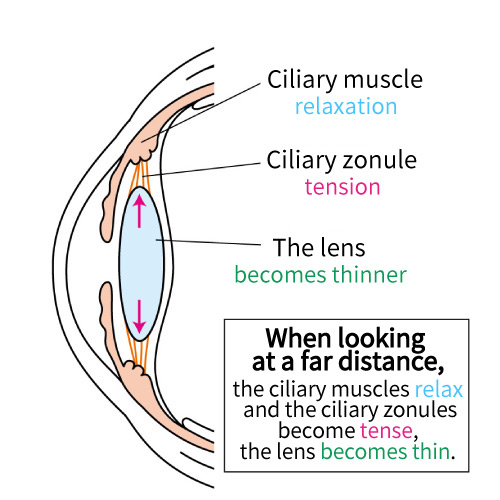-

 Copyright: Santen Pharmaceutical Co., Ltd.
Copyright: Santen Pharmaceutical Co., Ltd. -
Symptoms and progression of presbyopia
When presbyopia begins to develop, if you suddenly look into the distance while reading a book, your focus will immediately focus when you are young, but when you start presbyopia, blink your eyes and focus after a while. It takes time to focus near and far.
And it is easy to feel fatigue of the glasses. For example, working at the desk for a long time will make the eyes more fatigued. Just as people with good vision start presbyopia with age, people with myopia also start presbyopia with age. The symptom of presbyopia of myopia is the use of traditional glasses and contact lenses, which can clearly see the distance, but the near eyes are very blurred.
With the development of presbyopia, even if you try to adjust, it is difficult to focus, resulting in the inability to see close objects clearly. As shown in the figure below, the focal point is 17 cm at the age of 30, 25 cm after the age of 40, and as high as 50 cm at the age of 50.

-
Presbyopia supplements and presbyopia treatment
Supplements that are said to be good for the eyes include lutein, astaxanthin, vitamin A and blueberries. In addition, there is Hachimijiogan, which improves blood flow and water metabolism in the eyes, as a traditional Chinese medicine that is good for blurred vision.
Although these supplements and Chinese medicine are recommended as a measure against eye strain, there is no clear medical basis for the preventive or therapeutic effect of presbyopia.
However, since presbyopia is an aging change, it is also a fact that lutein and astaxanthin are attracting attention in anticipation of antioxidant effects as anti-aging.
If you want to treat presbyopia instead of correcting it with eyeglasses or contact lenses, surgery is still an option.
When treating presbyopia by surgery, those who have already started cataract after the age of 50 to 60 can treat presbyopia as well as myopia and astigmatism by using a bifocal intraocular lens in cataract surgery.
On the other hand, if you are between the late 40s and 50s and are still early in cataract surgery, you can cure presbyopia as well as myopia and astigmatism with bifocal contact lenses.
What is presbyopia?
Humans gradually realize that it is hard to see near when we were around 40 years old.
This is because when you were young, you could adjust the focus by changing the thickness of the lens, but as you age, the focus adjustment function declines.
Recently, it seems that the time to become aware of presbyopia tends to be younger due to the increase in the usage time of personal computers, smartphones, and tablets.
















